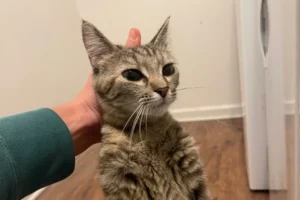Cats aren’t known for being the most cooperative creatures, especially when it comes to being picked up or restrained. Have you ever noticed that when you grab a cat by the scruff of their neck, they seem to freeze in place? Why is that?
The Scruff Reflex Explained
Have you ever wondered why cats seem to freeze in place when you grab them by the neck? This behavior is actually rooted in a biological response known as the scruff reflex. When cats are grabbed by the scruff of their neck, it triggers a reflex that causes them to go limp and immobile. This instinct is a remnant of their kittenhood, where mother cats would carry their young by the scruff of the neck to move them to safety.
The scruff reflex is a defense mechanism that cats have developed over time to protect themselves from harm. By going limp when grabbed by the neck, a cat is less likely to get hurt in a potentially dangerous situation. So, the next time you notice your feline friend freezing up when you grab their neck, just remember it’s their natural instinct kicking in to keep them safe.
Understanding maternal instincts
When it comes to understanding why cats have such a strong response to being grabbed by the neck, it’s essential to consider the role of maternal instincts. Mother cats instinctively pick up and move their kittens by the scruff of the neck. This behavior helps the mother cat transport her kittens safely and enables her to discipline them when needed.
The connection between the scruff reflex and maternal instincts runs deep in a cat’s DNA. As kittens, they rely on their mother for care and protection, so the scruff reflex becomes ingrained in their behavior long-term. So, when you see a cat react strongly to being grabbed by the neck, it’s a testament to the powerful bond between a mother cat and her kittens.
Here’s an extra tip: Next time you’re around a cat and notice them freeze up when grabbed by the neck, try to comfort them gently afterwards. This can help reassure them and strengthen the trust between you and your feline companion.
Importance of proper handling
Properly handling your cat is crucial for their well-being and safety. One important technique often misunderstood is grabbing a cat by the scruff of their neck, also known as the scruff technique. Contrary to popular belief, this should only be used in specific situations, such as when a mother cat carries her kittens. Using this method on an adult cat can be painful and uncomfortable for them, potentially leading to unnecessary stress. Instead, opt for gentle handling techniques like supporting their body and allowing them to feel secure. By understanding how to handle your cat properly, you can build trust and ensure a positive interaction every time.
Mythbusting misconception
There is a common misconception that when you grab a cat by the scruff of their neck, they become immobilized due to a reflex. While it is true that grabbing the scruff can trigger a cat’s instinct to go limp, this does not mean they are voluntarily immobile. In reality, this response mimics the behavior of kittens who go limp when their mother carries them. This should not be mistaken for a cat being calm or comfortable with this handling method. It is essential to remember that adult cats may find scruffing distressing and should only be done by a professional or in specific situations where it is necessary. By debunking this myth, you can better understand your cat’s behavior and cultivate a positive relationship with them.
Additional tip: Never use the scruff technique on an adult cat unless directed by a veterinarian or professional. It can cause unnecessary stress and discomfort.
Respecting feline boundaries
When it comes to handling cats, it’s crucial to respect their personal space and boundaries. Cats are independent creatures and can be sensitive to being handled in certain ways. One main reason why cats freeze when you grab their neck is due to their natural instinct to protect themselves. In the wild, a predator might grab a cat by the neck to subdue or harm them, so in a domestic setting, some cats may perceive this action as a threat.
To build trust with your feline friend, always approach them gently and avoid grabbing them by the neck. Instead, opt for petting them on their head, chin, or back, areas where they typically enjoy being touched. When handling your cat, be mindful of their body language – if they seem tense or uncomfortable, give them space and try again later. By respecting your cat’s boundaries and preferences, you’ll create a positive and trusting relationship with them.
Tips for respecting feline boundaries:
- Observe their body language: Pay attention to your cat’s cues like flattened ears, dilated pupils, or a tense body, indicating they may not be comfortable with how they are being handled.
- Use gentle touch: Approach your cat calmly and pet them in areas they enjoy, avoiding sudden movements or grabbing their neck.
- Give them space: If your cat shows signs of stress or discomfort, respect their boundaries and allow them to retreat to a safe and quiet space.
Adapting handling techniques
Understanding that each cat is unique and has their own preferences and comfort levels is essential for adapting your handling techniques. Some cats may enjoy being picked up and cuddled, while others may prefer to have their space respected. When it comes to why cats can’t move when you grab their neck, it’s essential to consider their individual personalities and past experiences.
If your cat freezes or appears uncomfortable when you grab their neck, try different handling techniques to see what they respond positively to. Some cats may prefer gentle strokes or scratches, while others may enjoy interactive play sessions. By adapting your approach to cater to your cat’s preferences, you’ll strengthen your bond and ensure they feel safe and secure in your presence.
Remember, building a positive relationship with your cat takes time and patience. By being responsive to their needs and adjusting your handling techniques accordingly, you’ll create a harmonious and fulfilling connection with your feline companion.
Fun facts about cat behavior
Did you know that cats have a unique instinct called the “scruff reflex” that causes them to go limp when they are grabbed by the neck? This reflex is linked to the way mother cats carry their kittens. When a mother cat picks up her kittens by the neck, she triggers this reflex, causing them to become immobile.
Cats also have a sensitive area at the back of their necks where important nerves and muscles are located. When you grab a cat by the scruff of the neck, you are activating this area and triggering the scruff reflex. This is why cats seem to freeze or go limp when you grab them in this manner.
Another interesting fact is that adult cats can still show this reflex even though they are no longer being carried by their mothers. It’s a natural response that has been ingrained in cats’ behavior through evolution to help them feel safe and secure in potentially dangerous situations.
Tips for a happy feline friend
To ensure your cat feels safe and respected, it’s important to understand their instincts and boundaries. Avoid grabbing your cat by the scruff of the neck unless necessary for medical reasons and always do so gently.
Create a secure and comfortable environment for your cat by providing hiding spots, scratching posts, and vertical spaces for climbing. These help fulfill their natural instincts and provide them with a sense of security.
Spend quality time playing with your cat to build trust and strengthen your bond. Engage in interactive play sessions using toys to mimic hunting behaviors and keep your cat mentally stimulated.
Remember that every cat is unique, so observe your feline friend’s body language and behavior to understand their preferences and boundaries. By respecting their needs and instincts, you can create a harmonious relationship with your furry companion.
- Bonus Tip: Providing your cat with a high-quality diet, regular veterinary care, and plenty of mental stimulation can contribute to their overall well-being and happiness.
Alex, a passionate animal lover, has experience in training and understanding animal behavior. As a proud pet parent to two dogs and three cats, he founded AnimalReport.net to share insights from animal experts and expand his knowledge of the animal kingdom.




